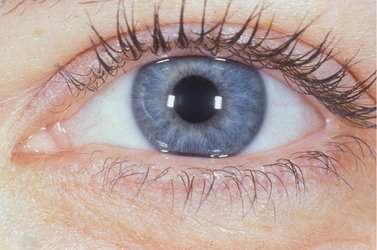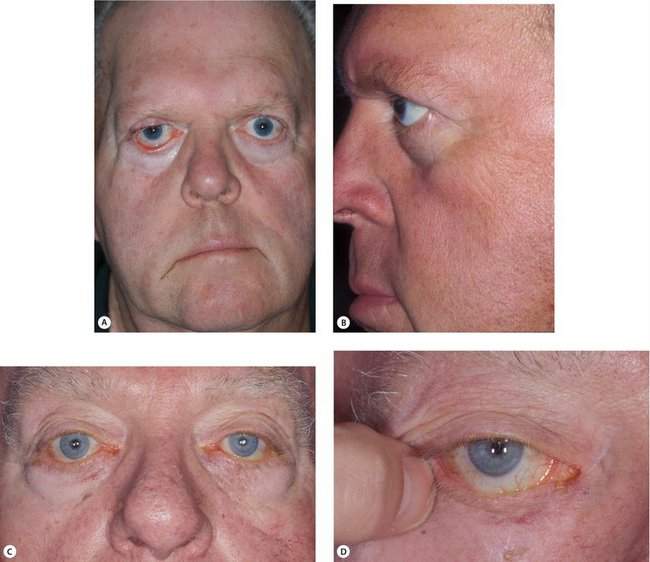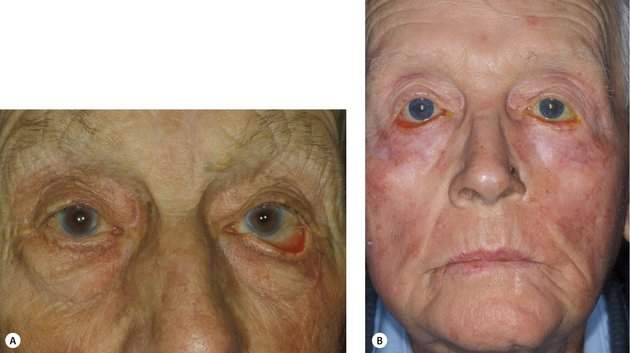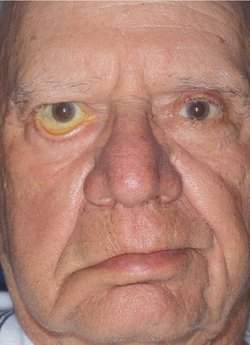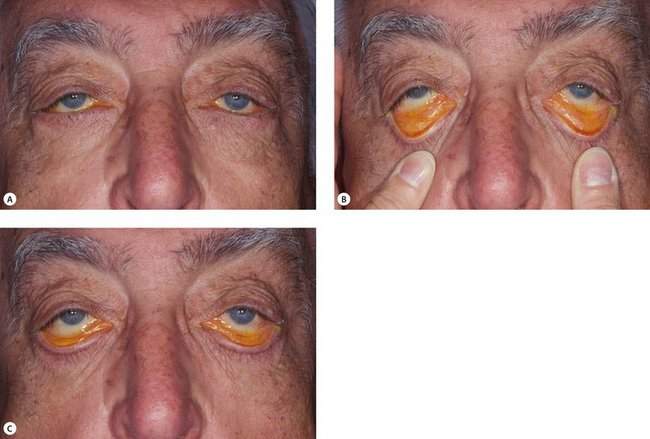CHAPTER 3 Diagnosis and Treatment of Ectropion
Anatomic considerations
Normal eyelid anatomy
The normal lower lid rests at the limbus (Figure 3-1; also see Figure 2-1). There is normally no sclera visible between the lower lid margin and the limbus. The lower eyelid apposes the eye for the entire length of the eyelid. There should be no separation of the posterior lid margin from the eye. The lateral canthus is slightly higher than the medial canthus. The lower lid punctum sits in the tear lake at the conjunctival plica. The next time you look at a patient with the slit lamp, notice that the normally positioned punctum is not visible at the slit lamp without using your finger to slightly evert the punctum. Normal tear drainage will not occur if the punctum is vertical or upright. The normal tear lake should be approximately 1 mm high. You will see examples of excessive and inadequate tear lakes.
Abnormal eyelid anatomy
Midfacial hypoplasia
The bony architecture of the inferior orbital rim provides support for the lower eyelid. Individual and racial variations occur. Patients with higher cheekbones or prominent malar bones tend to have less ectropion. Asian patients tend to have a flat face with more prominent malar bones. Black patients tend to have less prominent malar bones. The bony architecture of white patients is intermediate. Patients with the so-called hypoplastic midface or maxilla have an inferior orbital rim that is somewhat posterior in relationship to the eyeball (Figure 3-2). These patients tend to have less support for the lower lid and may have lower lid retraction or ectropion. Another term for the hypoplastic maxilla is “hemiproptosis.” I like this term because it emphasizes the fact that the inferior half of the eye is more anterior than the orbital rim. Tightening of the lower lid in a patient with hemiproptosis may cause the eyelid to slide under the eye, so be careful in tightening any lower eyelid in a patient with hemiproptosis. The relationship of the maxilla to the inferior rim should be considered in patients undergoing lower eyelid blepharoplasty in order to avoid the common complication of eyelid retraction or “rounding” of the lower eyelid. You will see later that the term “hemiproptosis” is also referred to as a “negative vector” eyelid, especially in the context of lower eyelid cosmetic surgery.
Anterior lamellar shortening
The skin, orbicularis muscle, and orbital septum are normally flexible enough that spontaneous movement of the eyelids can occur. You are already familiar with the terms anterior lamella (skin and muscle) and posterior lamella (tarsus and conjunctiva). Scarring of the anterior lamella can cause a cicatricial ectropion (Figure 3-3). Lengthening of the shortened lamella by adding a full-thickness skin graft is the treatment for cicatricial ectropion. As you know, scarring of the posterior lamella also causes a cicatricial entropion.
Paralysis of the orbicularis muscle
The resting tone of the orbicularis muscle supports the tarsal plate and canthal tendons, helping to support the lower eyelid in the normal position. In patients with paralytic ectropion, the resting tone of the orbicularis muscle is reduced or absent (Figure 3-4). Ectropion occurs primarily in older patients who have an underlying element of lid laxity. In younger patients with facial nerve palsy, ectropion generally does not occur because there is no underlying lid laxity.
History
Symptoms
The history in ectropion is straightforward. You will want to understand what bothers the patient about the ectropion. Patients with ectropion usually complain of irritation, redness, or tearing. As the lower eyelid everts, the normally moist conjunctival tissues become exposed to air and dry out. The conjunctiva becomes erythematous and may cause a slight discharge. The irritation is usually mild, and some patients may choose to ignore recommended treatment for the ectropion. This is in contrast to entropion in which the irritation is more severe, and patients seldom refuse treatment. For some patients, the main complaint about the ectropion is the erythematous appearance of the lid margin. Tearing may accompany the ectropion. The cause of tearing may be punctal malposition or inadequate lacrimal pump function. Tearing is more severe in young patients than in older patients. A young patient with mild punctal eversion may complain of severe tearing, whereas an older patient with complete ectropion may have no complaints of epiphora. If tearing is present, you need to pay particular attention to the position of the punctum when you are correcting the eyelid position.
Physical examination
Etiology
Are cicatricial changes present?
The etiology of the ectropion is usually apparent. The first question to ask is Is the ectropion cicatricial? Is there scar tissue pulling the eyelid away from the eyeball? Look for any specific scarring of the periocular area that would indicate previous accidental or surgical trauma. Look to see if the patient has tight skin on the whole face. Some patients, despite their age, may have tight skin with very few wrinkles. These patients may have generalized skin shrinkage as a cause of the cicatricial ectropion. Cicatricial ectropion is less common than involutional ectropion (see Figure 3-3).
Is there facial asymmetry?
If there are no cicatricial changes, ask the question, Is there evidence of facial asymmetry suggesting paralytic ectropion? Patients with facial nerve palsy have associated flattening of the nasolabial fold and coexisting brow ptosis. Patients with paralytic ectropion have significant laxity of the involved lower eyelid. Be sure to check for evidence of corneal exposure that would require additional medical or surgical treatment aside from repair of the paralytic ectropion (Figure 3-4). The additional procedures used in the management of facial nerve palsy will be covered in Chapter 9.
Horizontal eyelid laxity
If the ectropion is not cicatricial and not paralytic, it must be involutional. Involutional ectropion occurs in older patients with eyelid laxity (Figure 3-5). The eyelid laxity can be demonstrated by the eyelid distraction test and the eyelid snap test.
The eyelid distraction test
The eyelid distraction test is performed by manually pulling the eyelid away from the eyeball. The lower lid should not move more than 6 mm off the eyeball (Figure 3-6).
The eyelid snap test
The eyelid snap test is performed by pulling the lower eyelid inferiorly toward the inferior orbital rim. An eyelid without lower eyelid laxity will spring back into position without a blink. The lax lower eyelid will remain away from the eye for a period of time. The amount of laxity can be grossly quantified by asking the patient to blink and counting the number of blinks required to return the lid to normal position. I note in the chart something like, “eyelid returns with two blinks.” You will find the eyelid distraction and eyelid snap tests very helpful (Figure 3-7). The amount of laxity is directly related to the treatment—shortening the eyelid with a lateral tarsal strip operation. Remember that involutional ectropion is one of the most common oculoplastic conditions you will see.
Floppy eyelid syndrome
This is a good place to talk about the floppy eyelid syndrome. Patients with this syndrome complain of unilateral or bilateral irritation and ocular injection. On examination, a papillary conjunctivitis present. No obvious upper or lower eyelid ectropion is present. The main diagnostic finding is an enormous amount of upper eyelid laxity, so much so that the eyelid can be folded on itself and easily turned inside out (Figure 3-8). The cause of the irritation seems to be nocturnal eversion of the extremely lax upper eyelid rubbing on the pillow. Even more interesting is the fact that the majority of these patients are obese men with obstructive sleep apnea caused by similarly lax tissue in the upper airway. If the sleep apnea has already been recognized, the patient is usually wearing a continuous positive airway pressure (CPAP) mask at night or has had a uveopalatoplasty to tighten the airway. If the patient does not have a diagnosis of sleep apnea, ask about snoring, sleepless nights, and daytime fatigue. If any of these symptoms are present, refer the patient to a sleep specialist, and you may save the patient from some serious cardiopulmonary consequences. The treatment for floppy eyelid syndrome is horizontal lid tightening of the upper eyelid (usually a pentagonal wedge resection).
Stay updated, free articles. Join our Telegram channel

Full access? Get Clinical Tree


